THE 37TH TANKBATTALION,
C-COMP, CCR, 4TH AD
DEPART FOR BASTOGNE
The 80th and 26th Infantry divisions and the
4th Armored
Division (on the left flank) moved out on December 22, 1944
towards
the now completely encircled Bastogne.
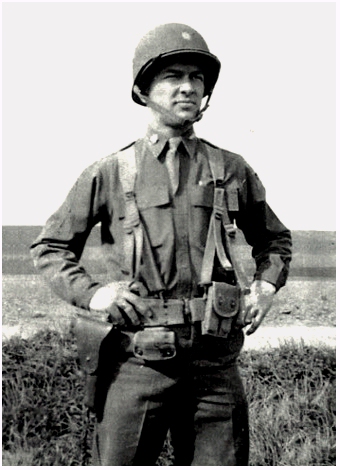 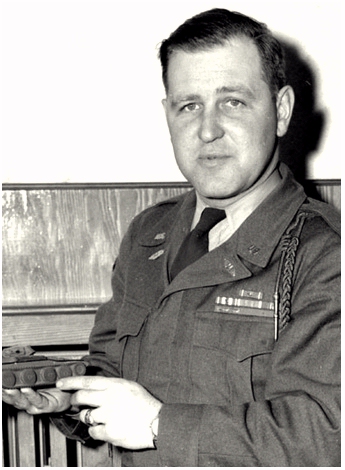
Major Albin F. Irzyk and, an after the war picture of,
Lt.Col. Creighton Abrams
The main force that was to drive towards Bastogne was CCB, under command by the
21 year old Major Albin F. Irzyk. He would send his units and some 1000 men to Chaumont
and further to Bastogne. But the Germans defended this region ferociously, and CCB lost
eleven Sherman tanks. On the right flank CCA was also struggling from Martelange towards
Warnach and lost five Sherman tanks. Combat Command Reserve (CCR) was also operating on
the right flank, but went to the left flank on Monday, December 25, to strengthen this
weak flank. CCR was moving towards Vaux-les-Rosieres, Petit-Rosière and then south-east towards Cobreville. The bridge near Cobreville was blown up by the Germans, and the Sherman tanks from CCR were halted. A Tank dozer was called up front to push rocks and stones into the stream so the tanks could push on. When the tanks finaly were moving again they headed for Remoiville where the opposition was fierce. Despite heavy opposition near Remoiville and man to man fighting the CCR took Remoiville around 18.00 hours, taking some 327 German prisoners in the process. General McAuliffe, the besieged commander of the 101st Airborne Division listened to the reports that were coming in and heard that the nearest units of the 4th Armored Division, the CCB, were stopped at Chaumont, just five miles south of Bastogne. McAuliffe remarked that it would take another 24 hours before the 4th Armored would reach Bastogne, maybe too late,... and told the only reporter with the 101st in Bastogne, Fred MacKenzie;
'We have been let down,...'. But as CCB and CCA were struggling, reports were coming in that CCR on the left flank moved north, and had reached Cobreville mid-afternoon.
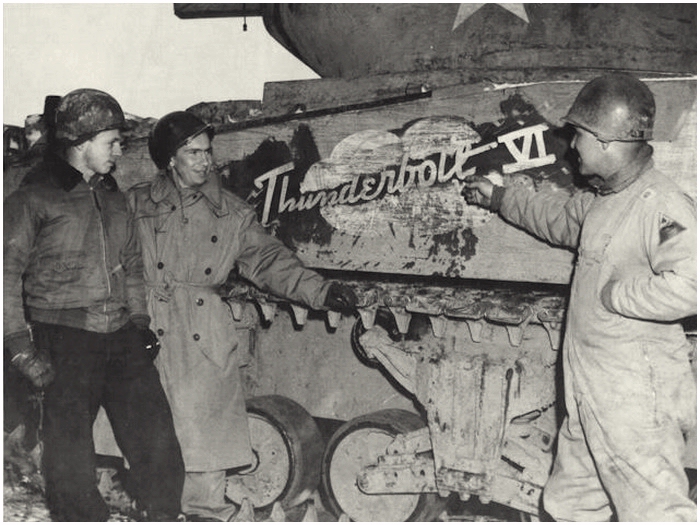
Lt.Col. Creighton Abrams points to the art
on his Sherman M4A3(76) 'Thunderbolt VI'
Next morning, December 26, Lt.Col. Creighton Abrams, commander of CCR, was standing
in his Sherman tank, 'Thunderbolt VI', an M4A3, and ordered that Baker Company, under
command of Capt. James Leach would take Remichampagne, so the road to Sibret, the last
town before Bastogne, could be taken. The artillery of the 4th Armored rained down in
and around the town of Remichampagne and the woods Bois de Cohet. West of Baker Company,
were two Charlie platoons under command of Lt. Charles Boggess, and he reported to Abrams,
that 'Troops observed going into the woods'. Abrams concluded that these were German troops.
They were mainly German Panzergrenadiers who thought they were safe in the woods.
But sixteen P-47's Thunderbolts from 377th Fighter Squadron plastered the woods of Bois
de Cohet with bombs, napalm and rockets. Around 10.00 hours, Baker Company tanks and
infantry of the 53rd Armored Infantry, entered Remichampagne to clean it from Germans.
At 11.20 hours, Boggess spotted six anti-tank guns that the Germans had brought into
position to cover the road between Remichampagne and Cobreville, these could destroy
all his tanks in a couple of minutes. So air support was called in to deal with these
AT guns. Fighterbombers of 379th Fighter Squadron were given the order. Meanwhile Abrams
drove towards Baker Company and met up with Leach in his 'Blockbuster'. He noticed a
German gun a thousand meters away and asked Leach to deal with it. But Abrams became
impatient and would not wait for a tank from Leach to take it out, he moved forward
himself and shot the gun (an AA) to pieces with 'Thunderbolt VI'. Leach recommended
Abrams the DSC for his action, because it was the colonel who was at the front knocking
enemy out, and colonels were not known for operating that close at the action.
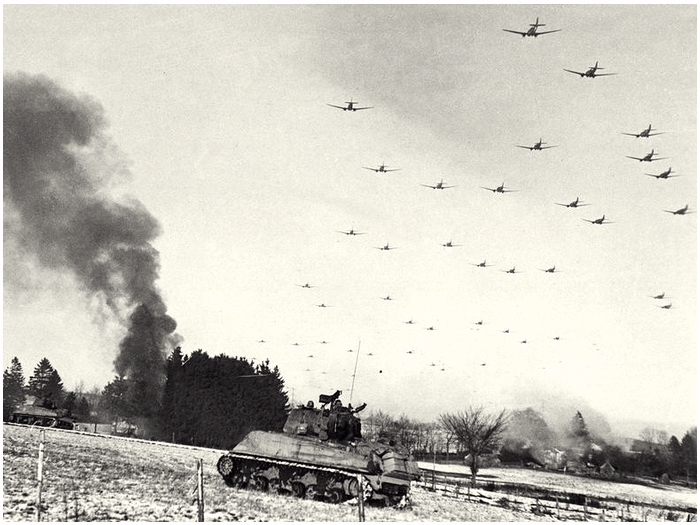
C-47 Skytrains bring supplies towards Bastogne
The men of the 4th Armored Division and their attached units looked up to the sky
when large groups of C-47's moved overhead towards Bastogne and dropped the much needed supplies
on parachutes over Bastogne. German Anti-Aircraft tried to pick the Dakota's from the air, with some succes.
Abrams called Boggess over to his tank. The 32 year old commander of C Company was just a
couple of days in charge of this unit, when his former commander was killed. Only nine tanks
were left in C Company, and support would come from 45 men of the 53rd Armored Infantry, but
Abrams urged Boggess to 'Get to those men in Bastogne'. Boggess went back to his tank
commanders and pointed their position in the column and their duty towards Bastogne.
Lieutenant Charles Boggess would lead the column in his M4A3E2 Jumbo, called 'Cobra King'.
The Jumbo had extra armor welded onto the tank to withstand German shells. Boggess pointed Lt.
Walter Wrolson as his next in line, and Milandro as third in line. Milandro and Wrolson commanded the newer M4A3 Sherman tank and it is not known of the 'art' of 'Casey Jones' had returned on the new Sherman (3082371). The new M4A3(75)W was built at Fisher Body and had the large hatch for the driver and his assistant with a 47 degree front armourplate. The 'W' in M4A3(75)W, stands for 'Wet stowage', in which that the shells were stored in a mixture of glycerine and water to protect them from exploding when hit by enemy fire. With the 'Wet stowage', the extra armour plates at the side was deleted. The crew in 'Casey Jones' at that time was, Walter Wrolson; commander, Claude E. Phenix; gunner, Hayes; loader, Walter E. Thomas; driver and Dennie W. Fesmir as the assistant driver/bow gunner.
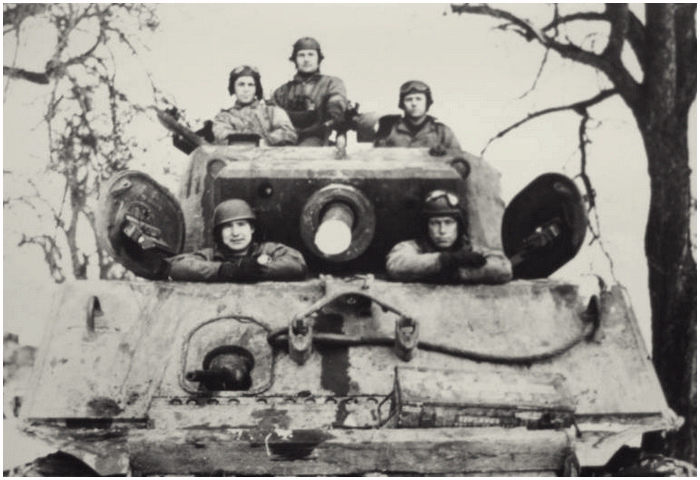
The crew of 'Cobra King', the M4A3E2 Jumbo commanded by Boggess
At 16.20 hours, Abrams gave with his hand the signal to move out. With guns blazing, machine guns rattling,
the tanks moved forward. Artillery was coming overhead, and smashed shells in front of the moving column.
'Cobra King' looked for targets in front, Walt Wrolson his tank fired to the right, and Milandro
his tank fired to the left. Gunner of 'Cobra King', Corporal Milton Dickerman stated later
he had used his 75mm gun as a machine gun, loader Murphy (Pvt James) smashed twenty-one rounds
in the breech in just a couple of minutes. As soon as the little column moved through Clochimont,
Boggess asked for artillery on Assenois. Shells were dropping everywhere, and it was even dangerous
for the column. Shrapnel rattled on the tanks armor. The hatches had to be closed because of
getting wounded by friendly fire. Periscopes of the drivers, obscured by dirt, could hardly be
used, and the drivers 'guessed' their way on the exploding road.
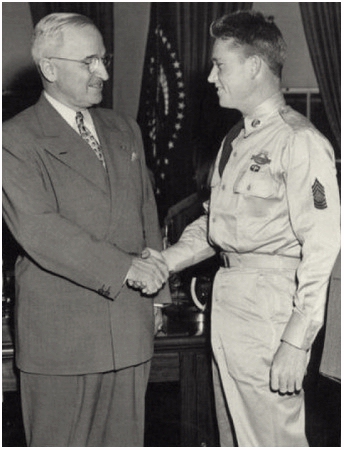
When the left brake locked from
'Cobra King', the tank took a wrong road, but backed up, and up they went again towards Bastogne. Friendly fire
and German shells prompted the infantry in their half tracks to dismount and seek shelter. Man
to man fights started when German Volksgrenadiers came out of their hiding.
James Hendrix
receives the MOH from President Truman
One of the infantrymen, the 19 year old James R. Hendrix, ran into two 8.8cm gun crews,
and took them prisoner with only his M1 rifle. He silenced two machine gun positions and
dragged a severly wounded GI from a burning wreck. Hendrix would later be granted the Medal of Honor.
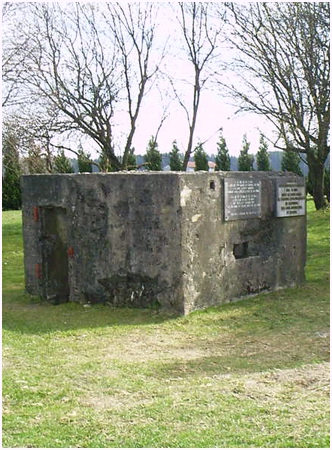
When dusk fell, the head of the column were just the Shermans of Boggess, Wrolson en Milandro, and these three
tanks cleared Assenois. In the gap behind them, the Germans were given the chance to throw 'Tellermine'
on the road. A Half Track was blown up by one. Cpt. Bill Dwight, from S-3, in his tank 'Tonto' helped
clear the wreckage from the road and toss the mines aside. A total of five Half Tracks were lost.
In 'Cobra King' the smell of cordite, the haze of smoke made it almost impossible to work in it.
Left; the pillbox still stands guard
On the right side of the road a small concrete pillbox appeared. From within Germans were shooting at the column.
But gunner Dickerman managed to put three rounds
into the pillbox, and silenced it. A couple of German soldiers, standing under fir trees were cut down by bow gunner
Harold Hafner (Hofner).
Walt Wrolson remembered it well, years later he recollected; 'traveling along a road in the forest
near Bastogne with the gunner firing the main gun of the M4 Sherman tank until we reached
a clearing where the 101st was located'.
When the treeline opened up, to open fields, Boggess slowed down, and
spotted many foxholes. He called out to the helmed figures who were peering over the barrels of
their rifles,...'Come on out, this is the 4th Armored'. It took some time before a soldier
emerged who put his hand out towards Boggess,...'I'm Lieutenant Webster of the 326th Engineers,
101st Airborne Division,...glad to see you,...'. In the journal log of CCR the entry was scibbled;
'Hole opened to surrouned forces at Bastogne'.
After the first three Shermans reached Bastogne, the fourth Sherman was 'Tonto' with S-3 Captain Dwight,
who reported to General McAuliffe. Not long after the first tanks of the CCR had rolled into town,
'Thunderbolt VI' with
Lt.Col. Abrams aboard, drove into Bastogne. Even if the 101st Airborne troopers had declared
that they were not to be liberated, they were relieved to see the 4th Armored. And what's
more, they had great respect for the tankers, as each crew in front was led by an officer. The
regular army had often no officer at the front line. The paratroopers felt a bond with these
tankers, because their officers were also always at the front to be found. Even when the road from
the south was cleared, it was far from safe. Armor from A and B Company
were ordered to take up positions and defend the flanks. Supply trucks and ambulances
rolled into Bastogne that same nght, escorted by the light tanks of D Company, 37th Tank Battalion.
In Assenois a German Battalion with Regimental CP's was stationed. During the fighting in and around
Assenois some 428 Germans were taken prisoner.
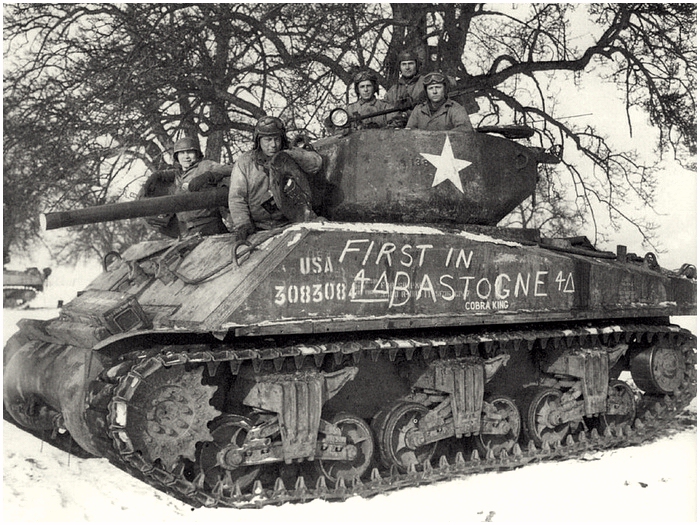
The most famous picture of 'Cobra King', the first tank into Bastogne,...
The next day, December 27, the corridor was widened and Lt. Col. Creighton Abrams asked Boggess for
a list who the first men were that drove their tanks into Bastogne. The first three are
known for certain, Boggess, Wrolson and Milandro, but after that it becomes unsure.
Some publications, such as 'WWII Journal #3, Battle of the Bulge', editor Ray Merriam, 2007,
has as fourth Sherman the tank 'Tonto' from Captain Dwight, while the list of Boggess
shows the Sherman from K.J. Smith as the fourth tank into Bastogne. But when Boggess has all the names
of 1st and 2nd Platoon, he has only the commander his name, Ford, of the fifth tank. He even has no
type or serial number of the tank commanded by Ford (could this be the tank of Captain Dwight, 'Tonto'?).
The list Boggess produced in Bastogne was, in my opinion, the personal and equipment check in Bastogne which tanks of the two platoons
from CCR made it into Bastogne. Even the tanks with mechanical problems are mentioned.
FIRST TANKS OF THE 37TH TANK BATTALION,
C-COMP, CCR, 4TH AD INTO BASTOGNE
|
TANKTYPE - NR. - NAME - 1 PLT |
COMMANDER |
DRIVER |
GUNNER |
LOADER |
BOWGUNNER |
|
M4A3E2 (3083084), 'Cobra King' |
CH. BOGGESS |
H. SMITH |
DICKERMAN |
MURPHY |
HOFNER |
|
M4A3 (3082371), 'Casey Jones' |
W. WROLSON |
THOMAS |
PHENIX |
HAYES |
FESMIR |
|
M4A3
(3081889), (unknown) |
MILANDRO |
NUNN |
KLAMEK |
INZINNA |
(unknown) |
|
M4A1 (3033546),
(unknown) |
K.J. SMITH |
SWINEHART |
WOODS |
HEMBREE |
BENNET |
|
Unkown |
FORD |
(unknown) |
(unknown) |
(unknown) |
(unknown) |
(Captain Dwight his tank 'Tonto' came
in as 4th tank into Bastogne)
|
TANKTYPE - NR. - NAME - 2 PLT |
COMMANDER |
DRIVER |
GUNNER |
LOADER |
BOWGUNNER |
|
M4A1 (3033887), (unknown) |
DROBICK |
POLCE |
GLINKA |
SAUSOL |
WALKER |
|
M4A3 (3082118), (unknown) |
DUNN |
GRICE |
(unknown) |
FURLANICH |
SHLINSKY |
|
M4A3
(3082084), (unknown) |
LUSZENYK |
LISCAVAGE |
MALICOAT |
FERARO |
GELAZELA |
|
TANKTYPE - NR. - NAME - Ukn. |
COMMANDER |
DRIVER |
GUNNER |
LOADER |
BOWGUNNER |
|
M4(105)
(301036725), HQ |
MYERS |
HALL |
ELKINS |
O'SMITH |
SHINER |
The two tanks below were out of action before CCR reached Bastogne
|
TANKTYPE - NR. - NAME - Ukn. |
COMMANDER |
DRIVER |
GUNNER |
LOADER |
BOWGUNNER |
|
M4A3E2 (308058) - Prob. 2nd Platoon |
TOWLEY |
? |
? |
? |
? |
(Noted on the
list by Boggess: 'Needs new clutch')
|
TANKTYPE - NR. - NAME - Ukn. |
COMMANDER |
DRIVER |
GUNNER |
LOADER |
BOWGUNNER |
|
M4A1 (3033244) - Prob. 2nd Platoon |
JACKSON |
? |
? |
? |
? |
(Noted by Boggess: 'Gyro & Power Tray out -
Bazooka hole in left turret, thru star')
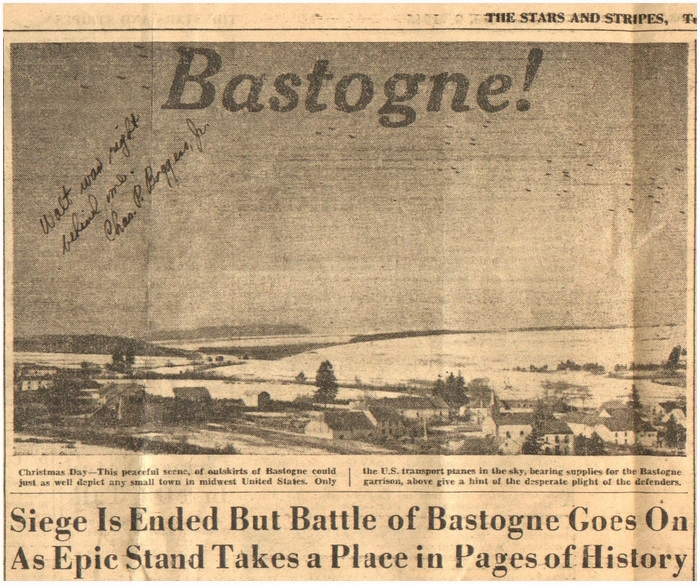
A clipping from 'Stars and Strips', Tuesday Januari 9, 1945
(signed by Chas P. Boggess Jr.: 'Walt was right behind me')
Click on the clipping for enlargement
In a correspondence back to the US Lt. Wrolson sent back a Stars and Stripes newspaper,
which documented all this above happening. Lt. Boggess signed it and he added, "Walt was right behind me".
General Patton wrote to 4th Armored General Gaffey the following commendation:
"The outstanding celerity of your movement and unremitting, vicious and skillful
manner in which you pushed the attack, terminating at the end of four days and nights
of incessant battle in the relief of Bastogne, constitute one of the finest chapters
in the glorious history of the United States Army. You and the officers and men of your
command are hereby commended for a superior performance". For its relief of Bastogne the
4th Armored was later awarded with the Presidential Unit Citation.
On 10 January the 37th Tank Battalion was attacking east of Bastogne when the order came
to halt. The 37th got a position in the 3rd Army reserve, ready to answer any fire calls.
It was around this point in time that Lt. Wrolson became the maintenance officer for Company
C of the 37th Tank Battalion as the previous maintenance officer, Dick Lamison, was transferred
to a divisional post. On 22 February 1945, General Patton ordered his tanks back in action and
Outscheid, Mioderwinger, Baustert, Feilsdorf, and Koosbrisch quickly fell to the 37th.
On 25 February, the 37th took Rittersdorf and shot a bridgehead over the Nimes River.
In only four days the 37th had led the 3rd Army as it pierced the Siegfried Line.
On March 5, 1945 the tanks of the 37th attacked over the Kull River. For the next
few weeks the 37th was engaged in cleaning out the Palatinate, the triangle formed
by the Saar, Rhine and Moselle Rivers.
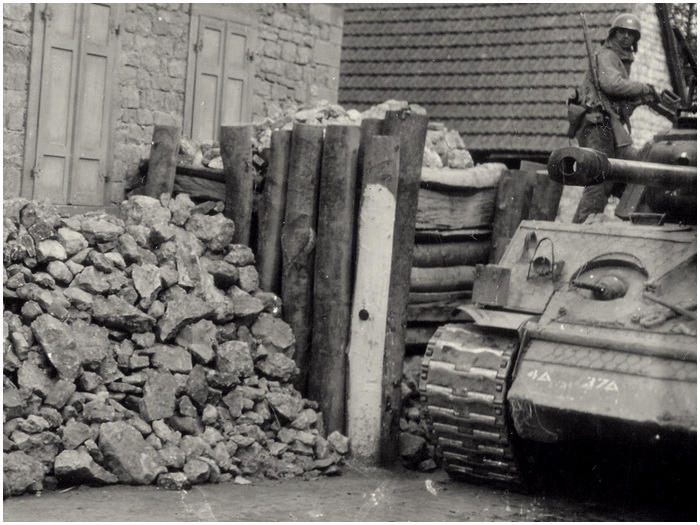
An M4A3(76)W from the 37th TB, 4th Armored Division, in Germany
The 3rd Army was hoping to find a bridge
intact that would take them across the Rhine river. The German retreating troops were
so desperate to reach the other side of the river, and not to let the bridges fall into
enemy hands, that they blew the bridge, even loaded with own troops and material still on
it (as witnessed by Major Al Irzyk, who was horrified of this onslaught).
But, on 25 March, 1945 the 37th Tank Battalion crossed the Rhine near Oppenheim.
Sometime in the first months of 1945 Lt.Col. Creighton Abrams, commander of the 37th,
got a new Sherman, an M4A3E8 with a 76mm gun and Horizontal Volute Spring Suspension
(HVSS). It was his seventh tank in succession (four during
training in the U.S. en three in Europe) and named it therefor 'Thunderbolt VII'.
For the next chapter,...
Click below on the 4th A.D. Sherman,
Frankfurt, Germany, 28 March 1945
|